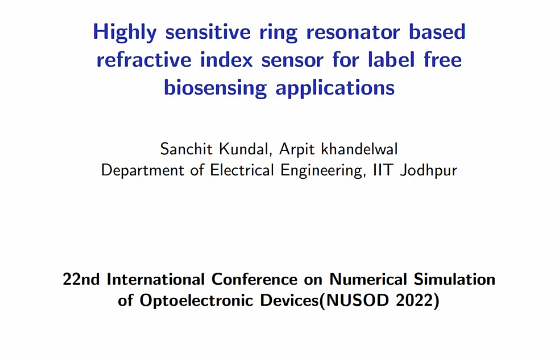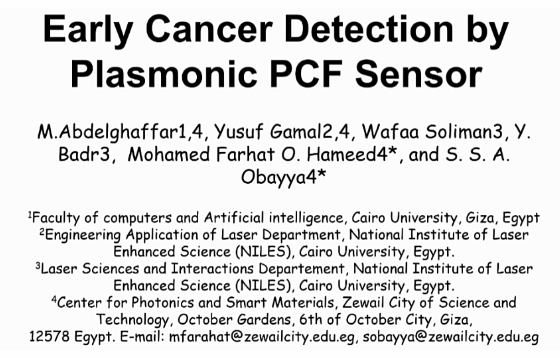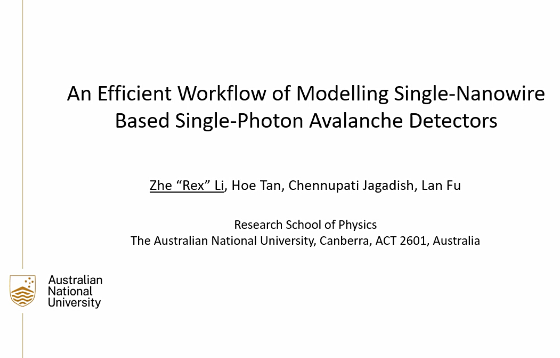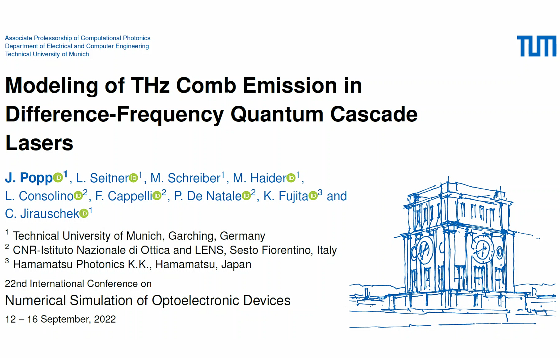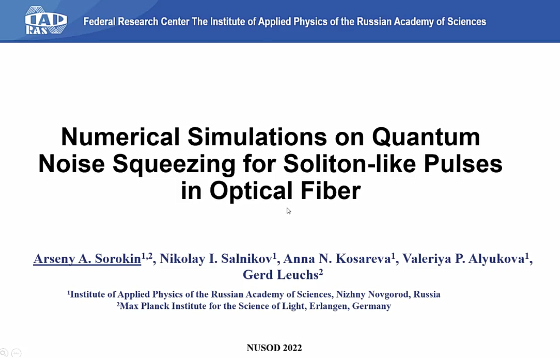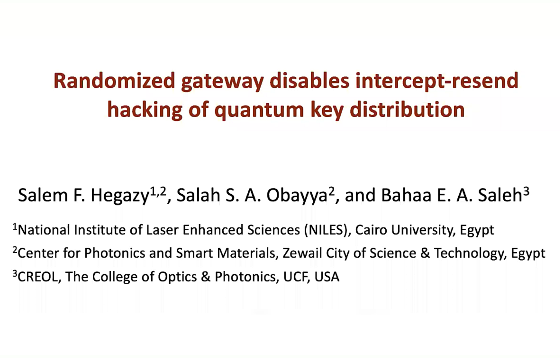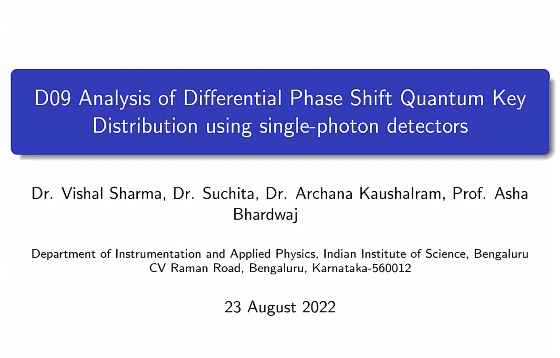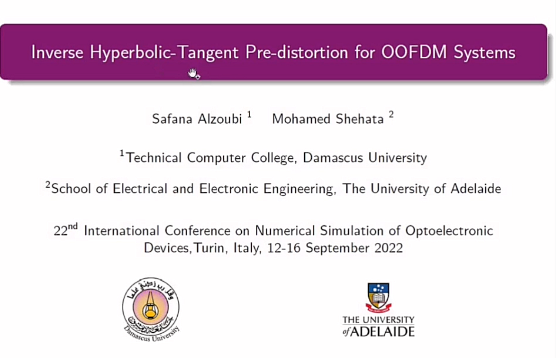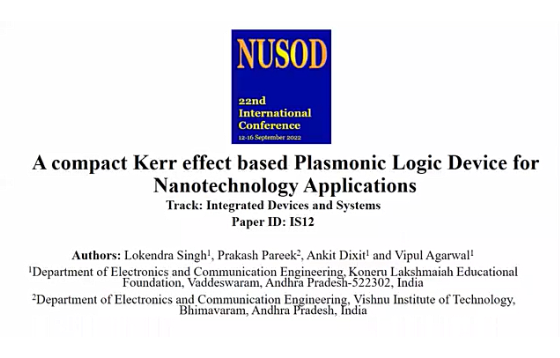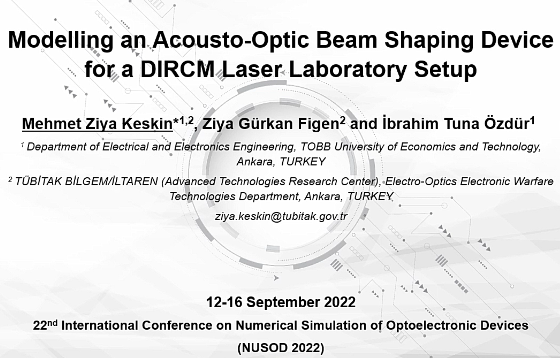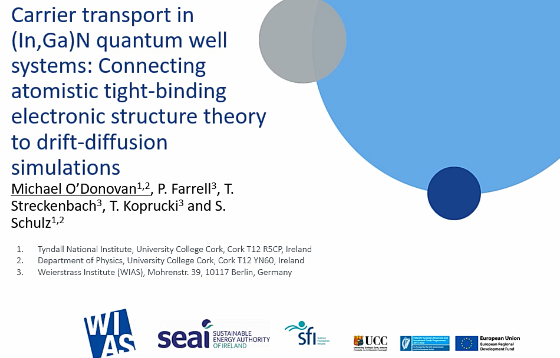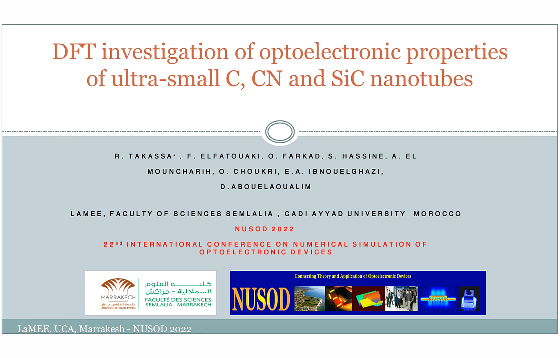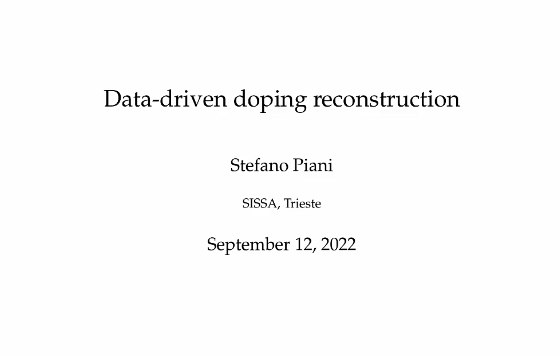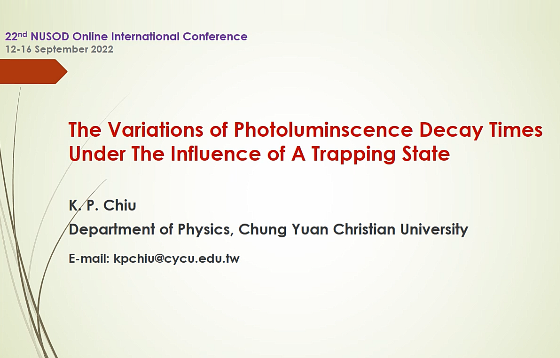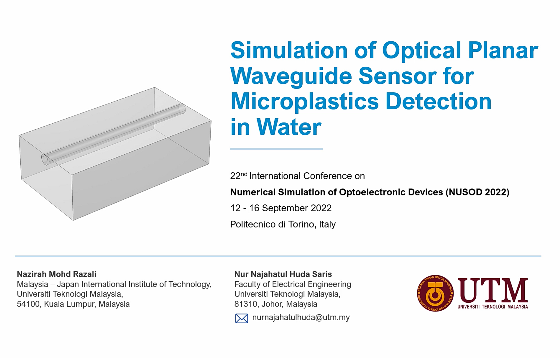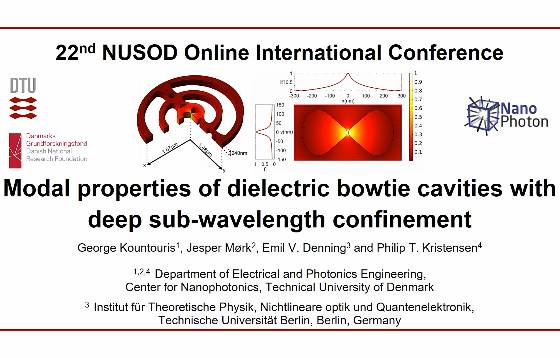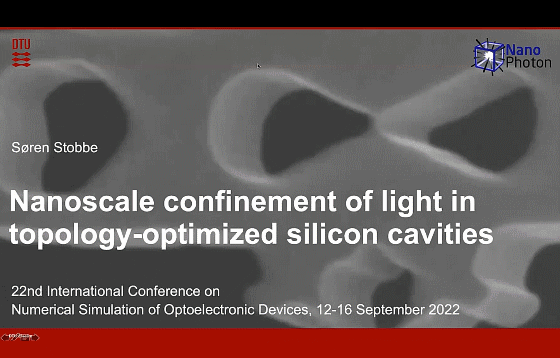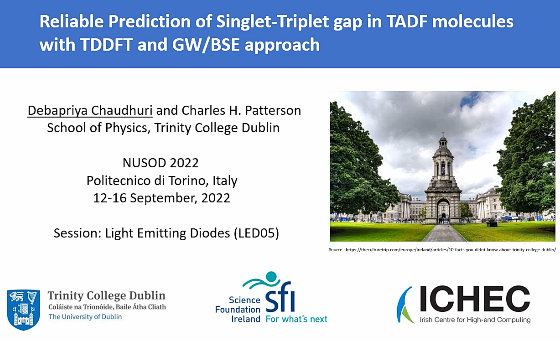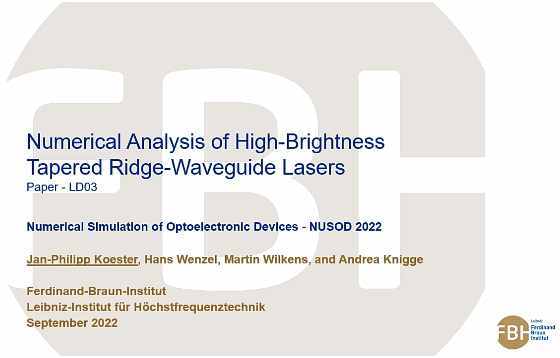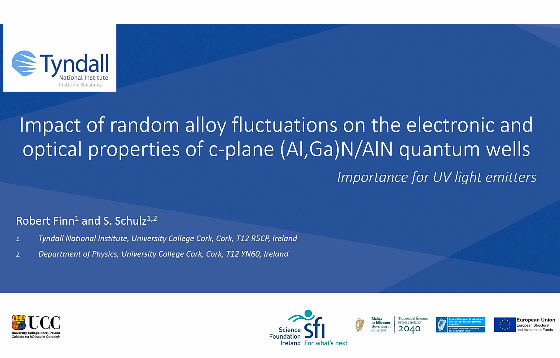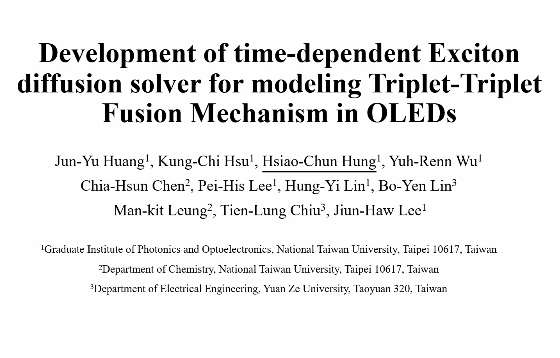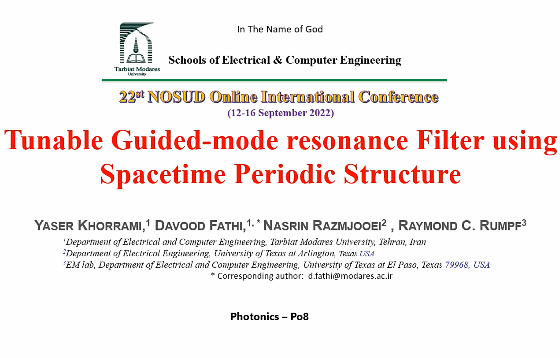


Ring resonator based label free refractive index biosensor is proposed for detecting glucose and hemoglobin concentrations. To improve device sensitivity and Q factor, various parameters of ring resonator are optimized. The designed ring resonator sensor can sense hemoglobin and glucose concentrations with a high sensitivity of 424 nm/RIU and Q factor of 802.
NM07 – Early Cancer Detection by Plasmonic PCF Sensor
Great research work has been studied for cancer detection due to its high death rate. In this paper, a novel design of photonic crystal fiber (PCF) biosensor based on surface plasmon resonance (SPR) is introduced and numerically analyzed for cancer cell detection. Full vectorial finite element method (FVFEM) is used throughout the numerical analysis of […]
N04 – An Efficient Workflow of Modeling Single-Nanowire Based Single-Photon Avalanche Detectors
Single-photon detector (SPD) as an essential building block for detecting and counting photons, plays a fundamental role in quantum technologies. In this work, we propose an efficient workflow of modeling SPDs based on emerging one-dimensional materials, i.e. nanowires, utilizing avalanche breakdown in reverse biased condition. Comparing to another extensively studied platform, superconducting nanowire SPDs, avalanche […]
LD08 – Modeling of THz Comb Emission in Difference-Frequency Quantum Cascade Lasers
The generation of terahertz (THz) frequency comb emission by intracavity difference frequency generation (DFG) in a mid-infrared (mid-IR) quantum cascade laser (QCL) is a promising alternative to direct THz QCL frequency comb generation. Concerning their room temperature operation capabilities, these devices are well suited for applications in rotational molecular spectroscopy and sensing. In order to […]
P03 – Numerical Simulations on Quantum Noise Squeezing for Soliton-like Pulses in Optical Fiber
Generation of light with nonclassical properties, such as squeezed light, has gathered a lot of attention because of possible uses in such areas as quantum state engineering, quantum imaging, continuous variable quantum computing, and detection of gravitational waves. Squeezed light is generally produced by transporting light through a nonlinear medium. One such media is Kerr-nonlinear […]
MM05 – Comparison of flux discretizations for varying band edge energies
Recently, a multiscale framework was developed where drift-diffusion is combined with atomistic tight-binding models. A naive flux discretization was proposed to tackle the problem of heavily fluctuating band edge energies which does not take into account mathematical complications. Here we would like to present several alternatives and compare them.
IS03 – Polarization-randomized gateway against detector-blinding hacks of quantum key distribution
A quantum key distribution system –employing a key time-bin qubit and a security-pass polarization-randomized qubit– is shown to overcome a wide class of intercept-resend attacks adopting the use of faked-state light; including attacks based on blinding of single-photon avalanche detectors (SPADs).
D09 – Analysis of Differential Phase Shift Quantum Key Distribution using single-photon detectors
We investigated the performance of differential phase shift quantum key distribution using InGaAs/InP and Silicon-APD (avalanche photo diode) for generating secure keys, secure communication distance, and bit error rates under the various operating conditions.We compare the quantum bit error rate and the secure key generation rate as a function of communication length.Our simulation results show […]
IS15 – Inverse Hyperbolic-Tangent Pre-distortion for OOFDM Systems
We propose an inverse hyperbolic-tangent-based digital pre-distorter that can suppress the Mach-Zehnder modulator-induced harmonic distortions by about 13 dB for single-tone signals, while maintaining the peak-to-average power ratio in optical orthogonal frequency division multiplexed signals.
P07 – Low-Cross-Talk Metal-Dielectric-Metal Waveguide Intersections Based on Sodium
We analyzed the transmission properties of two plasmonic waveguides crossing by using numerical simulations. The subwavelength width waveguides are composed of sodiumair-sodium. The crossing structure is composed by a compact cross-shaped resonant cavity with a four-fold symmetry. The results demonstrated the feasibility of using sodium as a low loss material for several applications for nanoplasmonic […]
IS12 – A compact Kerr effect based Plasmonic Logic Device for Nanotechnology Applications
This work utilizes the vital property of Kerr effect of altering the phase of optical signal to numerically investigate the plasmonic XOR/XNOR logic device for nanotechnology applications. Extinction ratio (ER) and insertion loss (IL) of basic switching element (Mach-Zehnder interferometer) is evaluated and plotted as a function of length of interferometric arms. The obtained result […]
NM06 – Modelling an Acousto-Optic Beam Shaping Device for a DIRCM Laser Laboratory Setup
Directed Infrared Counter Measure (DIRCM) laser laboratory setups are used to mimic the real life DIRCM system and IR heat-seeking missile engagement scenarios in isolated laboratory environments. Typically, the output beam of a mid-infrared (Mid-IR) laser source is modulated in time using an acousto-optic (AO) modulator (AOM). Following the AOM in the optical path, within […]
P17 – Simulation Analysis of Microring Resonator in Mobius Topology
In this paper, a microring resonator in Mobius topology is modelled and simulation analysis is carried out. The free spectral range of this silicon-on-insulator based photonic device is found to be 23.4 nm. This structure of microring resonator finds place in various applications such as sensors, polarization analysis, wavelength-selective reflectors.
MM02 – Carrier transport in (In,Ga)N quantum well systems: Connecting atomistic tight-binding electronic structure theory to drift-diffusion simulations
Understanding the impact of the alloy microstructure on carrier transport in (In,Ga)N/GaN quantum well systems is important for aiding device design. We study the impact that alloy fluctuations have on uni-polar carrier transport for both electrons (n-i-n junction) and holes (p-i-p junction) using a multiscale framework. To do so we connect an atomistic tight-binding model […]
N07 – DFT investigation of optoelectronic properties of ultra-small C, CN and SiC nanotubes
We investigated the optoelectronic properties of ultra-small armchair (3,3) carbon (C), carbon nitride (CN) and silicon cabride (SiC) nanotubes using the density functional theory (DFT). We performed the calculations for two potentials Perdew-Burke-Ernzerhof Generalized Gradient Approximation (PBEGGA) and Tran-Blaha modified Becke-Johnson (TB-mBJ) potential. The results show a semiconducting nature with direct and indirect gap for […]
MM08 – Data-driven doping reconstruction
To reconstruct doping profiles via opto-electronic techniques (e.g. LBIC and LPS), we formulate an inverse problem based on the van Roosbroeck system. To solve it, we use neural networks fed with data created from efficient implementations of the forward model. We discuss errors of the reconstructed doping profiles as well as their robustness with respect […]
MM11 – The Variations of Photoluminscence Decay Times Under The Influence of A Trapping State
We numerically calculated the time-resolved photoluminescence spectra using the bimolecular trapping-detrapping model. The variations of carrier lifetimes are investigated by changing the carrier recombination and trapping rate constants, as well as the concentration of available trapping states.
P20 – Simulation of Optical Planar Waveguide Sensor for Microplastics Detection in Water
Nowadays, microplastics pollution has become a global concern as it endangers the ecology, marine animals, and cause health threats to human beings. This paper attempted to simulate an optical planar waveguide sensor for microplastics detection in water via Wave Optics Module-COMSOL Multiphysics®. The analyte refractive index was ranged from 1.4800 to 1.5000 RIU, in reference […]
P02 – Modal properties of dielectric bowtie cavities with deep sub-wavelength confinement
We present a quasinormal mode analysis of a dielectric bowtie cavity with deep sub-wavelength confinement. The cavity – which is based on an inverse design by topology optimization – exhibits a remarkable sensitivity to local shape deformations, which we show to be well described by perturbation theory.
IS13 – Design and Performance Analysis of All Optical Half Adder based on Carrier Reservoir SOA -Mach Zehnder Interferometer (MZI) Configuration
In this manuscript, Carrier reservoir SOA (CR-SOA) based half adder is proposed and simulated at 100 Gb/s. CR-SOA has fast carrier recovery, due to presence carrier reservoir which enables its use at higher data rates on the other hand conventional SOA suffers from slow carrier recovery which leads to unequal amplification of pulses. The obtained […]
LED05 – Reliable prediction of the singlet-triplet gap in TADF molecules with GW/BSE approach
Organic light emitting diode (OLED) molecules that exhibit thermally activated delayed fluorescence (TADF) have emerged as a promising technology for various lighting and display applications. Such systems depend on low singlet-triplet gaps of the order of kT to allow reverse inter-system crossing. Here, we demonstrate the capability of a GW/BSE method to predict excitation energies […]
LD03 – Numerical Analysis of High-Brightness Tapered Ridge-Waveguide Lasers
In this work, we present a simulation-based analysis of a CW driven tapered ridge-waveguide laser having a high lateral brightness of 5 W · mm−1mrad−1 at 2.5 W optical output power.
P10 – Ultraviolet and Infrared Blocking Meta-glasses for Electric Vehicles
The air-conditioning systems installed in electric vehicles (EVs) consume a significant portion of battery power, thus, limiting EVs’ operating mileage. A design of an automobile windshield that can passively control the heat and light transmitted through it, could improve EV’s performance by reducing the need for air-conditioning. Here, we present a ‘meta-glass’ coating design that […]
P06 – Flexible, Process-Aware Compact Model of Effective Index in Silicon Waveguides for Commercial Foundries
We report the performance of a compact model for the effective index of SOI wire waveguides, showing exceptional agreement with simulated effective index and confinement factors. The development of such a model represents a potential pathway toward better modeling of silicon photonic devices in commercial foundry processes.
NM02 – Impact of random alloy fluctuations on the electronic and optical properties of c-plane AlxGa1−xN/AlN quantum wells
We present a theoretical study of the electronic and optical properties of c-plane AlxGa1−xN/AlN quantum wells emitting in the ultraviolet-A (UV-A) to UV-C spectral range. Special attention is paid to the impact of alloy fluctuations on the results. We find that random alloy fluctuations in (Al,Ga)N are already sufficient to cause strong carrier localization effects. […]
LED04 – Development of time-dependent Exciton diffusion solver for modeling Triplet-Triplet Fusion Mechanism in OLEDs
In this work, we developed a both stable and time-dependent exciton diffusion model including singlet and triplet exciton coupled with a modified Poisson & drift-diffusion solver to demonstrate the mechanism of triplet-triplet fusion (TTF) OLEDs. Using this modified simulator, we can demonstrate the characteristics of OLEDs including current-voltage curve, quantum efficiency performance, time-resolved electroluminescence spectrum, […]
LED09 – Enhanced optoelectronic properties of UV-C light-emitting diode
We numerically analyzed proposed structure named as LED S2 in comparison to reference structure LED S1. In LED S2 we introduced undoped AlGaN and p-AlGaN layers between the electron blocking layer (EBL) and the p-GaN (hole injecting layer). The simulation finding shows proposed structure (LED S2) provide a better strategy for lowering electron overflow and […]
P08 – Tunable Guided-mode resonance filter using Spacetime Periodic Structure
We present a tunable planar guided-mode resonance (GMR) filter using time-varying permittivity along grating nanobars. Results show that the effective medium concept in the temporal state is exactly the same as the spatial state. Furthermore, the structure has spatial periodicity to save the resonance peak of the passive GMR in addition to the temporal periodicity […]
MM06 – Dual-Potential Finite-Difference Technique for Computational Electrodynamics
We present a finite-difference time-domain (FDTD) technique suitable for coupling with quantum-transport solvers. We derive first-order equations for the electric and magnetic vector potentials and the electric scalar potential which, upon the adoption of the Coulomb gauge, decouple into solenoidal and irrotational equation sets and are sourced by the solenoidal and irrotational parts of the […]

